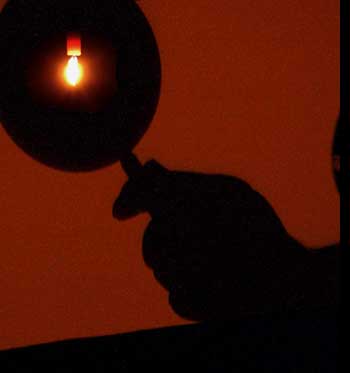

|
Have you ever looked through a magnifying glass? The clear glass (or plastic) in a magnifying glass is a lens, like the lens that’s inside your eye.
Using the lens of a magnifying glass,
You can try the same thing at home. For instructions on how to make
an image with a magnifying glass,
click
here
.
|
|
What’s Going On? Suppose you use your magnifying glass to make an image of a tree on a sunny day. You hold your lens between the tree and a piece of paper. You move the lens to just the right spot. Voilà! There’s an image of the tree. That image is made of light. Sunlight bounces off the tree and spreads out in all directions. Your lens gathers the light shining out in all directions from each spot on that tree and bends that light so it all comes back together on a single spot on your piece of paper. So light shining from a leaf at the top of the tree ends up on one spot on your paper. Light shining from a spot on the tree’s trunk ends up in a different spot on your paper. All these spots of light blend together in your eye to make an image. |
|
 you
can bend light to make an image of the world. Look at the photo
on the left. We used a magnifying glass to produce an inverted image
of a candle. The photo on the right shows how.
you
can bend light to make an image of the world. Look at the photo
on the left. We used a magnifying glass to produce an inverted image
of a candle. The photo on the right shows how.
